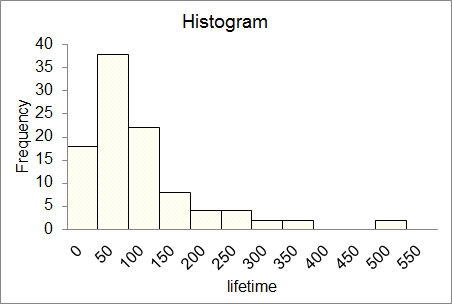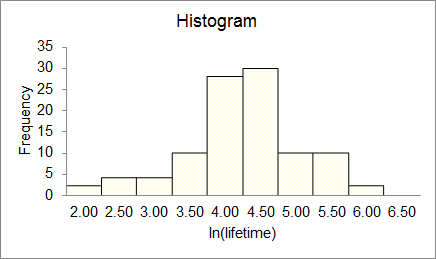#149 The paper Study on the Life Distribution
The paper Study on the Life Distribution - Math
ChemistryExplain daily providing Q&A content “#149 The paper “Study on the Life Distribution" in Bridges math curriculum, Dr mather, Carnegie math, 10th maths, 10th grade math problems, Math.Get the Free Online Chemistry Q&A Questions And Answers with explain. To crack any examinations and Interview tests these Chemistry Questions And Answers are very useful. Here we have uploaded the Free Online Chemistry Questions. Here we are also given the all chemistry topic.
ChemistryExplain team has covered all Topics related to inorganic, organic, physical chemistry, and others So, Prepare these Chemistry Questions and Answers with Explanation Pdf.
For More Chegg Questions
Free Chegg Question
The paper “Study on the Life Distribution of Microdrills” (J. of Engr. Manufacture, 2002: 301–305) reported the following observations, listed in increasing order, on drill lifetime (number of holes that a drill machines before it breaks) when holes were drilled in a certain brass alloy.
a. Why can a frequency distribution not be based on the class intervals 0–50, 50–100, 100–150, and so on?
b. Construct a frequency distribution and histogram of the data using class boundaries 0, 50, 100, . . . , and then comment on interesting characteristics.
c. Construct a frequency distribution and histogram of the natural logarithms of the lifetime observations, and comment on interesting characteristics.
d. What proportion of the lifetime observations in this sample are less than 100? What proportion of the observations are at least 200?
For More Chemistry Notes and Helpful Content Subscribe Our YouTube Chanel - Chemistry Explain
Free Chegg Answer
(a)
In the given data set, the observation is falls in the specified boundary of 50. Because the class intervals specified as 0–50, 50–100, 100–150, and so on. So, the frequency distribution is not based on the class intervals.
In the given data set, the observation is falls in the specified boundary of 50. Because the class intervals specified as 0–50, 50–100, 100–150, and so on. So, the frequency distribution is not based on the class intervals.
(b)
Using excel Add-Ins MegaStat the frequency distribution and histogram for the data is as follows:
Using excel Add-Ins MegaStat the frequency distribution and histogram for the data is as follows:
| lifetime | ||||||
| lower | upper | midpoint | width | frequency | percent | |
| 0 | < | 50 | 25 | 50 | 9 | 18.0 |
| 50 | < | 100 | 75 | 50 | 19 | 38.0 |
| 100 | < | 150 | 125 | 50 | 11 | 22.0 |
| 150 | < | 200 | 175 | 50 | 4 | 8.0 |
| 200 | < | 250 | 225 | 50 | 2 | 4.0 |
| 250 | < | 300 | 275 | 50 | 2 | 4.0 |
| 300 | < | 350 | 325 | 50 | 1 | 2.0 |
| 350 | < | 400 | 375 | 50 | 1 | 2.0 |
| 400 | < | 450 | 425 | 50 | 0 | 0.0 |
| 450 | < | 500 | 475 | 50 | 0 | 0.0 |
| 500 | < | 550 | 525 | 50 | 1 | 2.0 |
| 50 | 100.0 |
The output for the histogram is,

The shape of the histogram is appears to be right skewed with an outlier. There is variability in lifetimes, because the values are at the upper end of the data.

The shape of the histogram is appears to be right skewed with an outlier. There is variability in lifetimes, because the values are at the upper end of the data.
(c)
Taking the natural logarithm for the data and then using excel Add-Ins MegaStat the frequency distribution and histogram for the data is as follows:
Taking the natural logarithm for the data and then using excel Add-Ins MegaStat the frequency distribution and histogram for the data is as follows:
| ln(lifetime) | |||||
| lower | upper | midpoint | width | frequency | |
| 2.00 | < | 2.50 | 2.25 | 0.50 | 1 |
| 2.50 | < | 3.00 | 2.75 | 0.50 | 2 |
| 3.00 | < | 3.50 | 3.25 | 0.50 | 2 |
| 3.50 | < | 4.00 | 3.75 | 0.50 | 5 |
| 4.00 | < | 4.50 | 4.25 | 0.50 | 14 |
| 4.50 | < | 5.00 | 4.75 | 0.50 | 15 |
| 5.00 | < | 5.50 | 5.25 | 0.50 | 5 |
| 5.50 | < | 6.00 | 5.75 | 0.50 | 5 |
| 6.00 | < | 6.50 | 6.25 | 0.50 | 1 |
| 50 |
The output for the histogram is,


The shape of the histogram is approximately symmetric, because there is a less variability in the distribution of ln(lifetime). There are no outliers in the transformed data.
(d)
The number of observations less than 100 is 19 (that is 50-100).
The total number of observations in the data set is 50.
The number of observations less than 100 is 19 (that is 50-100).
The total number of observations in the data set is 50.
The proportion of the lifetime observations in this sample are less than 100 is,

The number of observations are at least 200 is 7.
The total number of observations in the data set is 50.
The proportion of the lifetime observations in this sample are at least 200is,


The number of observations are at least 200 is 7.
The total number of observations in the data set is 50.
The proportion of the lifetime observations in this sample are at least 200is,

Labels: Chegg, Free Chegg Answer, Q&A Math


0 Comments:
Post a Comment
Subscribe to Post Comments [Atom]
<< Home